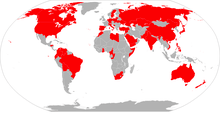Primate city
A primate city (Latin: "prime, first rank")[1] is the largest city in its country or region, disproportionately larger than any others in the urban hierarchy.[2] A primate city distribution is a rank-size distribution that has one very large city with many much smaller cities and towns, and no intermediate-sized urban centres: a King effect, visible as an outlier on an otherwise linear graph, when the rest of the data fit a power law or stretched exponential function.[3] The law of the primate city was first proposed by the geographer Mark Jefferson in 1939.[4] He defines a primate city as being "at least twice as large as the next largest city and more than twice as significant."[5] A primate city is number one in its country in most aspects, like politics, economy, media, culture and universities.
Significance

Not all countries have primate cities, but in those that do, the rest of the country depends on it for cultural, economic, political, and major transportation needs. On the other hand, the primate city depends on the rest of the country as paying consumers of the cultural, economic, political and other services produced in the area.
The presence of a primate city in a country may indicate an imbalance in development – usually a progressive core, and a lagging periphery, on which the city depends for labor and other resources.[6] However, the urban structure is not directly dependent on a country's level of economic development.[2]
Many of the primate cities are increasing their percentage of their country's population. This can be because the number of traditional workers have been reduced because of mechanization in the manufacturing industry, agriculture, and other blue-collar industries, which are generally located throughout all of the country. At the same time, the number of educated employees in service business such as politics, economy, culture, media, and higher education has been rising, and those sectors are often located in the capital where the power and money is concentrated.
Examples
Many alpha world cities are considered national and/or regional primate cities.[5][7] They include the two alpha++ world cities of London in the United Kingdom (national) and New York City in the United States (regional), though the U.S. has never had any primate city on a national scale.[8] In addition, Budapest, Dublin, Jakarta, Lima, Mexico City, and Seoul have also been described as primate cities within their respective countries.[9]
Bangkok, the capital of Thailand, has been called "the most primate city on Earth", being roughly thirty-five times larger than Thailand's second-largest city of Nakhon Ratchasima.[10] Taking the concept from his examination of the primate city during the 2010 Thai political protests and applying it to the role that primate cities play if they are national capitals, Jack Fong's study noted that when primate cities like Bangkok function as national capitals, they are inherently vulnerable to insurrectionary dynamics by the subaltern, and the dispossessed. He cites the simple fact that most primate cities serving as national capitals contain major headquarters for the country. Thus, logistically, it is rather "efficient" for national targets to be contested since they are all located within one major urban environment.[11]
Urban primacy
Urban primacy indicates the ratio of the primate city to the next largest i.e the second largest in a country or region. In other words, urban primacy can be defined as the central place in an urban or city network that has acquired or obtained a great level of dominance. The level of dominance is measured by population density and the number of functions offered. Higher functions and population will result in higher dominance.
See also
Notes
- ↑ "Primate". Merriam-Webster Online Dictionary. Merriam-Webster. Retrieved 2008-07-21.
From Old French or Frenchprimat, from a noun use of Latin primat-, from primus ("prime, first rank") - 1 2 Goodall, B. (1987) The Penguin Dictionary of Human Geography. London: Penguin.
- ↑ http://www.lboro.ac.uk/gawc/rb/rb186.html GaWC Research Bulletin 186
- ↑ The Law of the Primate City and the Rank-Size Rule, by Matt Rosenberg
- 1 2 Jefferson. "The Law of the Primate City", in Geographical Review 29 (April 1939)
- ↑ Brunn, Stanley et al. Cities of the World. Boulder, CO: Rowman & Littlefield Publishers, Inc, 2003
- ↑ Taşan-Kok, Tuna (2004). Mexico, Istanbul and Warsaw: Institutional and spatial change. Eburon Uitgeverij. p. 41. ISBN 978-905972041-1. Retrieved 2013-05-21.
- ↑ "The World According to GaWC 2012". Globalization and World Cities Research Network. Loughborough University. Retrieved 11 January 2017.
- ↑ Pacione, Michael (2005). Urban Geography: A Global Perspective (2nd ed.). Abingdon: Routledge. p. 83.
- ↑ "จำนวนเทศบาลตำบล">ส่วนวิจัยและพัฒนาระบบ รูปแบบและโครงสร้าง สำนักพัฒนาระบบ รูปแบบและโครงสร้าง กรมส่งเสริมการปกครองท้องถิ่น." [ออนไลน์]. เข้าถึงได้จาก: 2557. สืบค้น 6 กุมภาพันธ์ 2558.
- ↑ Fong, Jack (2013). "Political Vulnerabilities of a Primate City: The May 2010 Red Shirts Uprising in Bangkok, Thailand". Journal of Asian and African Studies. 48 (3): 332–347.